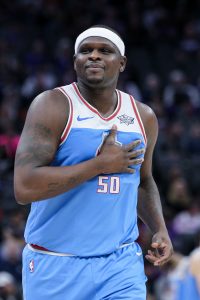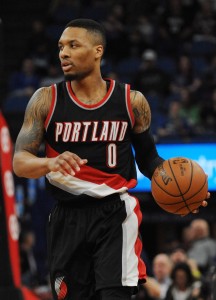After trading DeMarcus Cousins during the 2016/17 season, the Kings appeared poised to embark on a full-scale rebuild. However, they hedged their bets to some extent in the 2017 offseason, inking veteran free agents like George Hill, Zach Randolph, and Vince Carter to lucrative contracts in order to reach the salary floor.
Those free agent additions didn’t help much on the court in 2017/18, as the Kings fell out of playoff contention early and focused on developing their young players in the second half of the season. Now, Hill is gone and Carter seems likely to follow, as another year of rebuilding gets underway in Sacramento.
Here are five key questions facing the franchise this summer:
1. What will the Kings do with the No. 2 overall pick?
The Kings hadn’t had much luck in the draft lottery up until this week. Despite years of futility (Sacramento hasn’t made the playoffs since 2006), the franchise hadn’t secured a top-three pick since 1991. That streak ended this spring, as the Kings jumped up from No. 7 to No. 2 in the lottery standings, putting them in position to grab a potential franchise player.
Now the Kings’ front office will have to decide how to maximize the value of that second overall pick. Deandre Ayton and Luka Doncic are widely considered the top two prospects in this year’s draft. Should Sacramento simply be happy to take whichever one of those two doesn’t go No. 1? Will Marvin Bagley III or another player receive serious consideration? Would the Kings explore the possibility of trading down to pick up more assets?
Sacramento is only two years removed from making Georgios Papagiannis a lottery pick, so the front office hasn’t exactly earned the benefit of the doubt. Still, given the Kings’ prime position and the relative strength of this year’s class, it seems safe to assume that the team should come out of the draft with another building block to complement De’Aaron Fox.
2. Can the Kings get back into the first round of the 2019 draft?
If the Kings do decide to move down in the draft, last year’s Celtics/Sixers swap should serve as a template. In fact, the asset Boston picked up in that trade for moving down two spots will likely end up being Sacramento’s 2019 first-round pick. Missing their own first-rounder for 2019 is bad news for the Kings, who figure to remain a lottery team a year from now, but if they can find a way to acquire another ’19 pick, that would soften the blow.
The Kings could also look to the Nets as a reference point as they go shopping on the trade market. Despite having sent their own first-round picks to other teams for several years in a row, the Nets found ways to get back into the first round or to pick up other selections, either by trading their own veterans or taking on another teams’ unwanted contracts. The Kings can head into the new league year armed with cap space and expiring contracts, so they should have some options.
Read more
3. Will any veterans be bought out or traded?
Assuming all the Kings veterans with player options pick them up – Kosta Koufos already has – Sacramento will have almost $40MM on its 2018/19 cap for the expiring contracts of Koufos, Iman Shumpert, Garrett Temple, and Zach Randolph.
While there’s something to be said for having veteran mentors on the roster to help young players develop, those particular vets may want the opportunity to join a team closer to contention, and may be willing to give up a portion of their salaries for that opportunity.
Even if the Kings don’t gain any traction on buyout talks with any of those players, or simply aren’t interested in pursuing buyouts, their expiring contracts could make them interesting trade pieces. One potential scenario would see a cap-strapped team sending a player on a longer-term contract to the Kings in exchange for one of their expiring contracts. That cap-strapped club could then waive and stretch its newly-acquired player, perhaps avoiding tax territory, while the Kings would gain multiyear control of a player who better fits their timeline.
4. Will the Kings dive back into the free agent market?
The Kings currently project to have upwards of $19MM in cap room, which isn’t as much as they had available a year ago, but is still more than most teams will have.
From an outsider’s perspective, it didn’t seem as if the Kings’ strategy of bringing in veterans like Hill, Carter, and Randolph was a huge success, but it’s possible the team views it differently. If Sacramento considers the leadership and locker room presence of that type of player valuable, then perhaps we’ll see more short-term veteran signings using that cap space this summer.
However, I believe the more likely outcome for the Kings’ cap room involves pursuing a young free agent to add to their core, or using that cap space to accommodate another team’s salary dump and pick up an asset or two in the process. Both of those approaches could benefit Sacramento in the long run.
5. What can the team expect from Harry Giles?
One of the Kings’ most interesting moves in 2017 was the decision to trade down from No. 10 in the draft to pick up the 15th and 20th picks. They used that extra selection to nab Giles, a high-upside center with a history of knee issues.
The rebuilding Kings took an ultra-conservative approach with Giles during his rookie year, initially ruling him out until 2018 and then shutting him down for the season. The youngster is now set to make his long-awaited pro debut this July in Summer League action, barring any setbacks.
The Kings have used several draft picks on big men over the last several years, and some of those players have had a more successful transition to the pros than others — Willie Cauley-Stein, for instance, could be a long-term piece, while Papagiannis was waived before the end of his second NBA season. Still, none of those young bigs have emerged as a potential cornerstone player for the franchise.
Giles may not be that guy either, but if he can stay healthy, his promise is tantalizing. It will be interesting to see what Sacramento can get out of him in 2018/19.
Here’s where things currently stand for the Kings financially:
Guaranteed Salary
- Zach Randolph ($11,692,308)
- Bogdan Bogdanovic ($9,000,000)
- Kosta Koufos ($8,739,500): Exercised player option
- De’Aaron Fox ($5,470,920)
- Willie Cauley-Stein ($4,696,875)
- Buddy Hield ($3,833,760)
- Justin Jackson ($2,807,880)
- Harry Giles ($2,207,040)
- Matt Barnes ($2,133,542) — Waived via stretch provision
- Georgios Papagiannis ($2,000,400) — Waived
- Skal Labissiere ($1,544,951)
- Frank Mason ($1,378,242)
- Caron Butler ($517,219) — Waived via stretch provision
- Total: $56,022,637
Player Options
Team Options
Non-Guaranteed Salary
Restricted Free Agents
Unrestricted Free Agents / Other Cap Holds
Projected Salary Cap: $101,000,000
Projected Cap Room: $18,722,785
- Our cap projection for the Kings includes their 10 guaranteed contracts, the cap hold for their No. 2 overall pick, and the player options for Shumpert and Temple. Taking into account all those salaries and cap holds, and assuming all free agents are renounced, the Kings’ total team salary adds up to $82,277,215.
Footnotes:
- Hayes’ exact contract details, including guarantee info, aren’t yet known.
Note: Rookie scale cap holds are estimates based on salary cap projections and could increase or decrease depending on where the cap lands.
Salary information from Basketball Insiders was used in the creation of this post. Photos courtesy of USA Today Sports Images.





